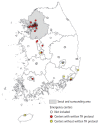A survey-based study on the protocols for therapeutic hypothermia in cardiac arrest patients in Korea: focusing on the differences between level 1 and 2 centers
- PMID: 27752600
- PMCID: PMC5052908
- DOI: 10.15441/ceem.15.018
A survey-based study on the protocols for therapeutic hypothermia in cardiac arrest patients in Korea: focusing on the differences between level 1 and 2 centers
Abstract
Objective: We aimed to summarize the therapeutic hypothermia (TH) protocols used in emergency departments (EDs) in Korea and to investigate the differences between level 1 and 2 centers.
Methods: The chief residents from 56 EDs were given a structured survey containing questions on the indications for TH, methods for TH induction, maintaining, and finalizing TH treatments. The participants were divided into 2 groups based on their work place (level 1 vs. level 2 centers).
Results: We received 36 responses to the survey. The majority of the participants (94.4%) reported that they routinely used TH. An average of 5.9 (standard deviation, 3.4) and 3.3 (standard deviation, 2.9) TH procedures were performed monthly in level 1 and 2 centers, respectively (P=0.01). The majority of level 1 and 2 centers (80.0% and 73.1%, respectively) had written TH protocols. Rectal (50.0%) and esophageal probes (38.9%) were most commonly used to monitor the patients' body temperatures. Midazolam (80.6%) and remifentanyl (47.2%) were the most commonly used sedatives. For TH induction, external cooling devices (77.8%) and cold saline infusion (66.1%) were predominant. Between level 1 and 2 centers, only the number of TH, the usage of remifentanyl, and application of external cooling device showed significant differences (P<0.05).
Conclusion: Our study summarizes the TH protocols used in 36 EDs. The majority of study participants performed TH using a written protocol. We observed small number of differences in TH induction and maintenance methods between level 1 and 2 centers.
Keywords: Clinical protocols; Heart arrest; Hypothermia; Republic of Korea.
Conflict of interest statement
No potential conflict of interest relevant to this article was reported.
Figures
Similar articles
-
Survey of the use of therapeutic hypothermia after cardiac arrest in UK paediatric emergency departments.Emerg Med J. 2013 Jan;30(1):24-7. doi: 10.1136/emermed-2011-200348. Epub 2012 Mar 2. Emerg Med J. 2013. PMID: 22389354
-
Improved survival with therapeutic hypothermia after cardiac arrest with cold saline and surfacing cooling: keep it simple.Emerg Med Int. 2011;2011:395813. doi: 10.1155/2011/395813. Epub 2011 Apr 12. Emerg Med Int. 2011. PMID: 22046539 Free PMC article.
-
Use of therapeutic hypothermia in postcardiac arrest patients by emergency departments.Ther Hypothermia Temp Manag. 2011;1(1):23-7. doi: 10.1089/ther.2010.0004. Ther Hypothermia Temp Manag. 2011. PMID: 24716884
-
Therapeutic hypothermia for acute myocardial infarction and cardiac arrest.Am J Cardiol. 2012 Aug 1;110(3):461-6. doi: 10.1016/j.amjcard.2012.03.048. Epub 2012 Apr 27. Am J Cardiol. 2012. PMID: 22541421 Review.
-
Therapeutic hypothermia following cardiac arrest: a review of the evidence.Nurs Crit Care. 2008 May-Jun;13(3):144-51. doi: 10.1111/j.1478-5153.2008.00267.x. Nurs Crit Care. 2008. PMID: 18426470 Review.
Cited by
-
Hypothermia Inhibits Endothelium-Independent Vascular Contractility via Rho-kinase Inhibition.Biomol Ther (Seoul). 2018 Mar 1;26(2):139-145. doi: 10.4062/biomolther.2016.233. Biomol Ther (Seoul). 2018. PMID: 28208012 Free PMC article.
References
-
- Peberdy MA, Callaway CW, Neumar RW, et al. Part 9: postcardiac arrest care. 2010 American Heart Association guidelines for cardiopulmonary resuscitation and emergency cardiovascular care. Circulation. 2010;122(18 Suppl 3):S768–86. - PubMed
-
- Nolan JP, Soar J, Zideman DA, et al. European Resuscitation Council guidelines for resuscitation 2010 section 1: executive summary. Resuscitation. 2010;81:1219–76. - PubMed
-
- Abella BS, Rhee JW, Huang KN, Vanden Hoek TL, Becker LB. Induced hypothermia is underused after resuscitation from cardiac arrest: a current practice survey. Resuscitation. 2005;64:181–6. - PubMed
-
- Nielsen N, Wetterslev J, Cronberg T, et al. Targeted temperature management at 33°C versus 36°C after cardiac arrest. N Engl J Med. 2013;369:2197–206. - PubMed
LinkOut - more resources
Full Text Sources
Other Literature Sources


